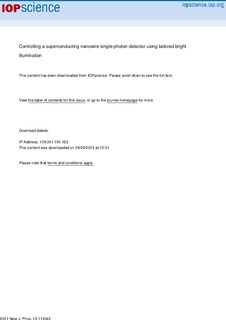| dc.contributor.author | Lydersen, Lars Vincent Van de Wiel | |
| dc.contributor.author | Akhlaghi, Mohsen K. | |
| dc.contributor.author | Majedi, A. Hamed | |
| dc.contributor.author | Skaar, Johannes | |
| dc.contributor.author | Makarov, Vadim | |
| dc.date.accessioned | 2015-09-29T11:31:53Z | |
| dc.date.accessioned | 2015-10-22T11:31:09Z | |
| dc.date.available | 2015-09-29T11:31:53Z | |
| dc.date.available | 2015-10-22T11:31:09Z | |
| dc.date.issued | 2011 | |
| dc.identifier.citation | New Journal of Physics 2011, 13 | nb_NO |
| dc.identifier.issn | 1367-2630 | |
| dc.identifier.uri | http://hdl.handle.net/11250/2357749 | |
| dc.description.abstract | We experimentally demonstrate that a superconducting nanowire
single-photon detector is deterministically controllable by bright illumination.
We found that bright light can temporarily make a large fraction of the
nanowire length normally conductive, can extend deadtime after a normal
photon detection, and can cause a hotspot formation during the deadtime with
a highly nonlinear sensitivity. As a result, although based on different physics,
the superconducting detector turns out to be controllable by virtually the same
techniques as avalanche photodiode detectors. As demonstrated earlier, when
such detectors are used in a quantum key distribution system, this allows an
eavesdropper to launch a detector control attack to capture the full secret key
without this being revealed by too many errors in the key. | nb_NO |
| dc.language.iso | eng | nb_NO |
| dc.publisher | IOP Publishing | nb_NO |
| dc.title | Controlling a superconducting nanowire single-photon detector using tailored bright illumination | nb_NO |
| dc.type | Journal article | nb_NO |
| dc.type | Peer reviewed | en_GB |
| dc.date.updated | 2015-09-29T11:31:53Z | |
| dc.source.volume | 13 | nb_NO |
| dc.source.journal | New Journal of Physics | nb_NO |
| dc.identifier.doi | 10.1088/1367-2630/13/11/113042 | |
| dc.identifier.cristin | 863593 | |
| dc.description.localcode | © IOP Publishing Ltd and Deutsche Physikalische Gesellschaft. Creative Commons Attribution License. | nb_NO |
